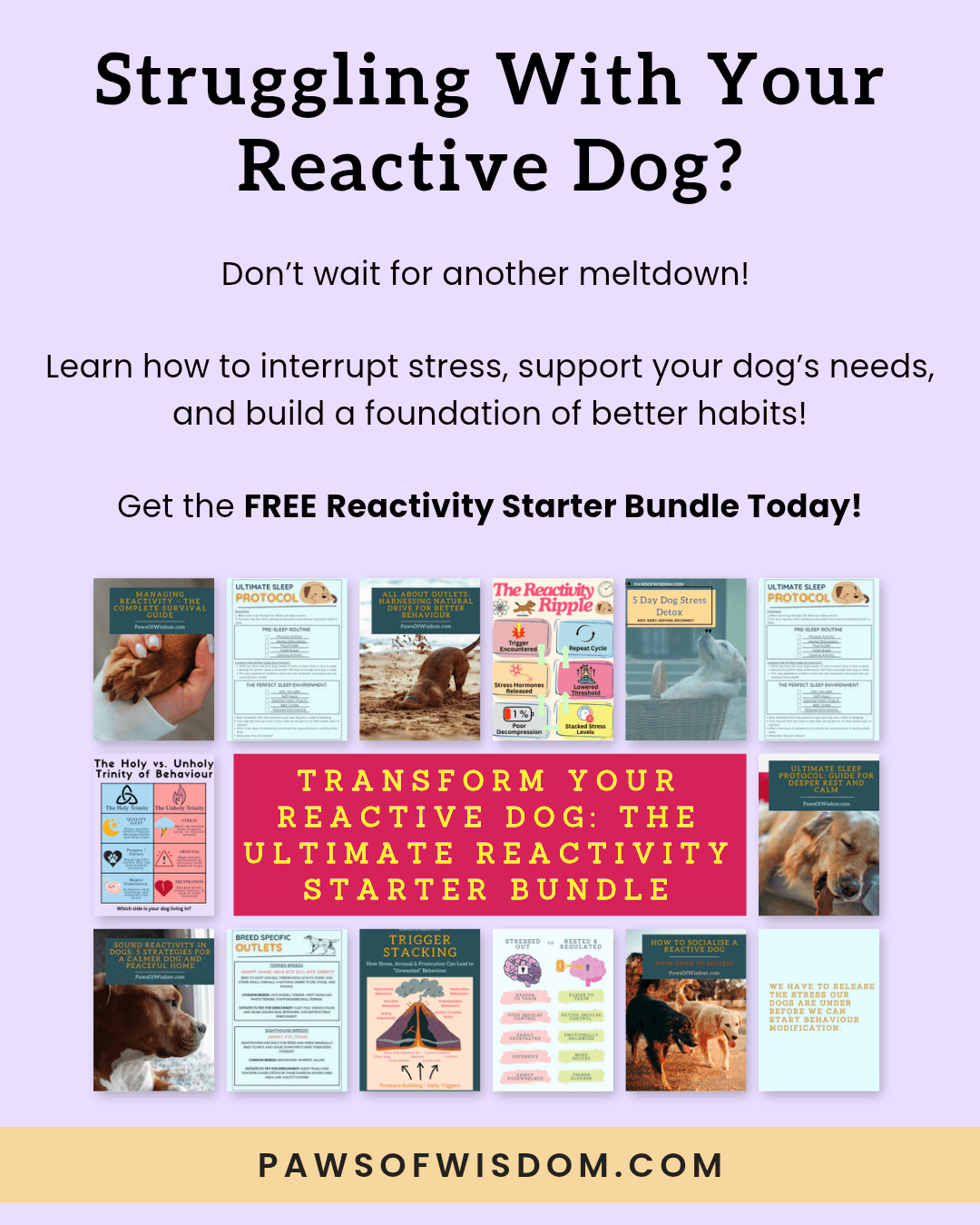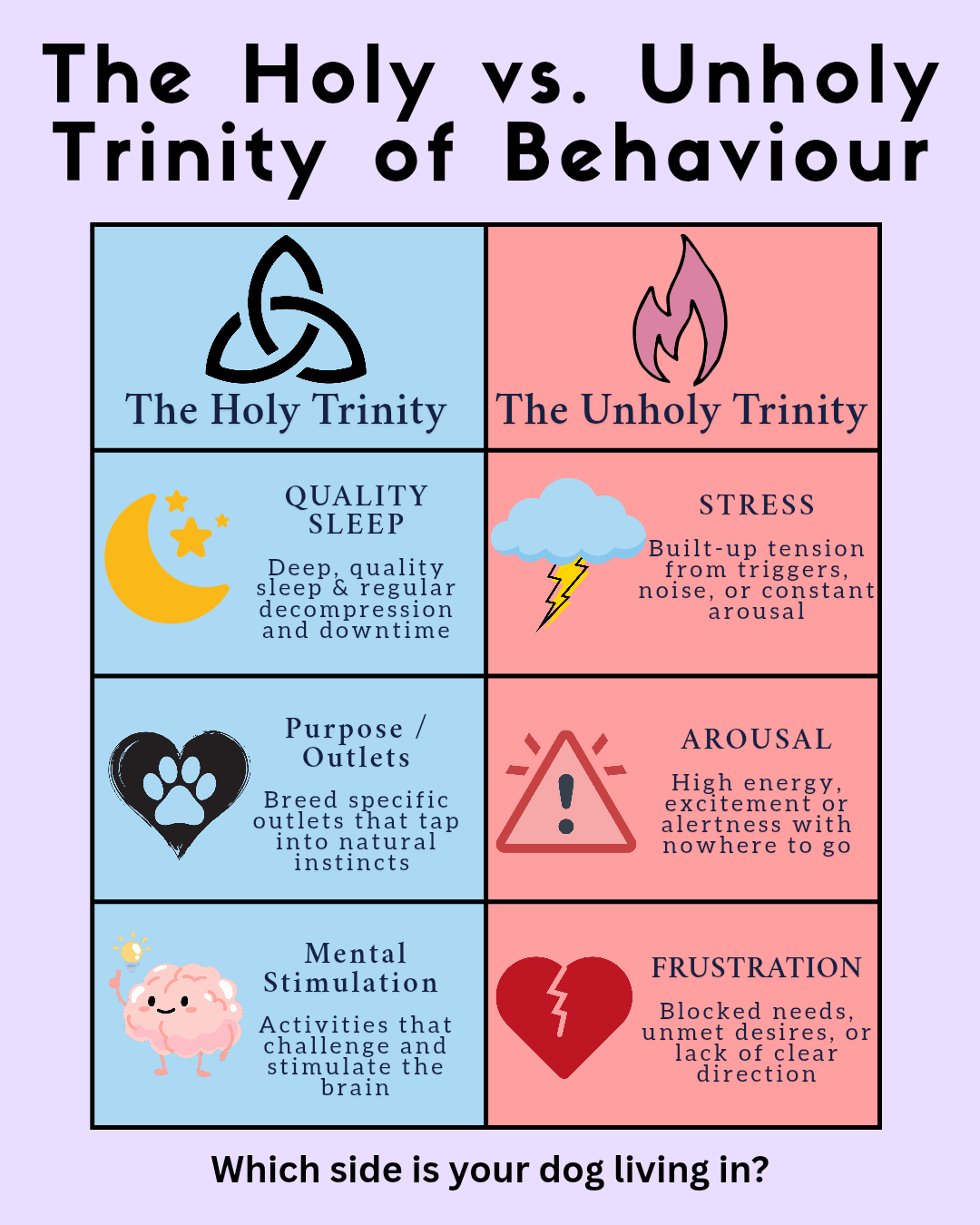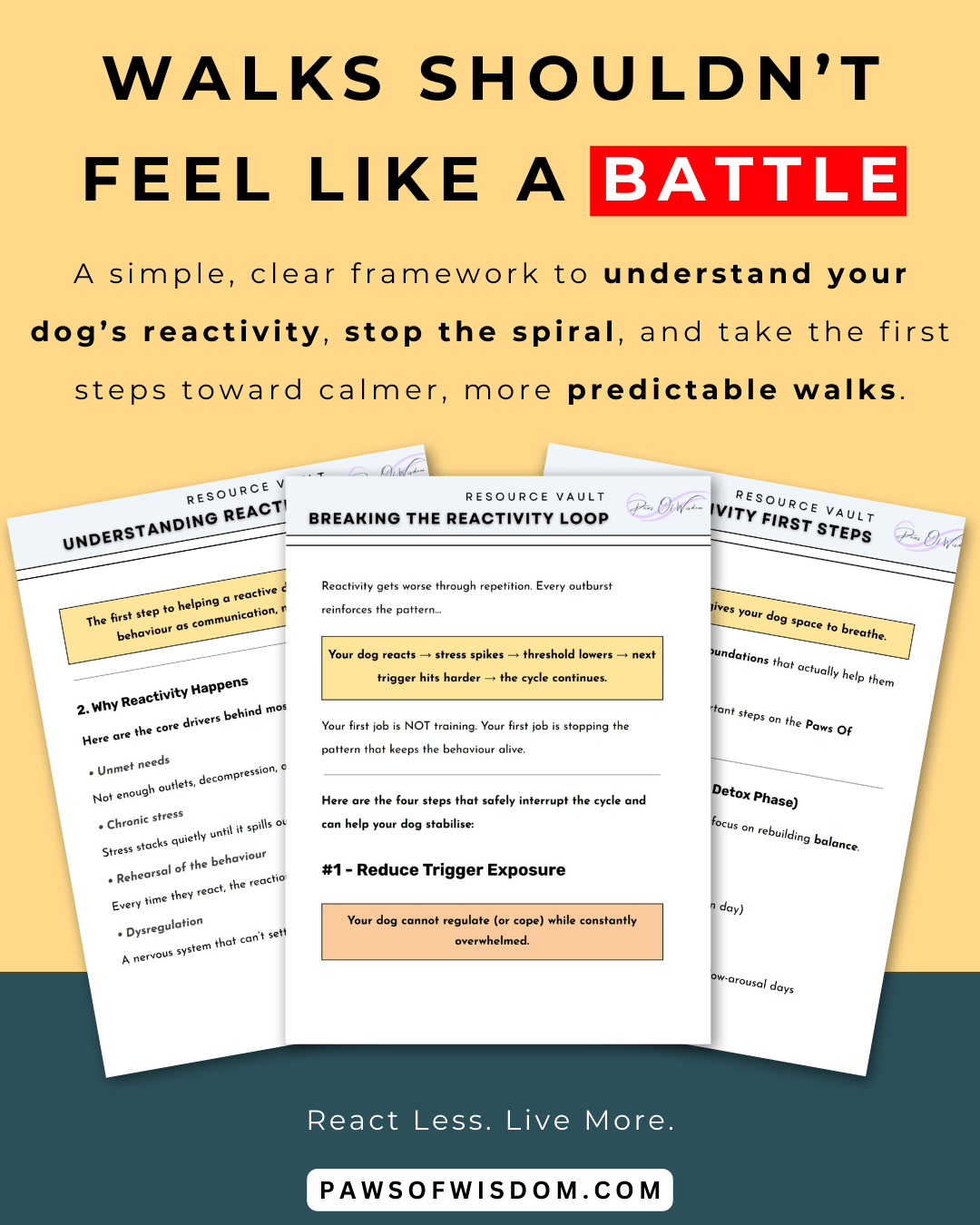How to Deal with a Reactive Dog (Without Losing Your Mind)
Wondering how to deal with a reactive dog — without chaos, overwhelm, or constant setbacks? You’re in the right place.
Walking your dog shouldn’t feel like a battlefield — but for many reactive dog owners, that’s exactly what it is. Barking, lunging, growling on the lead, freezing in fear, hypervigilant behaviour — it’s not just frustrating, it’s exhausting.
You’re trying to do the right thing. You take your dog out and expose them to people and dogs, hoping things will get better. Instead, it feels like they’re getting worse. Sound familiar?
This blog post is going to break all of that down — step by step. I'll talk about what reactivity really is, why it happens, and what your dog actually needs to start improving.
You're about to learn a "nervous-system-first" approach to reactivity where you’ll learn how to reset their nervous system, meet their needs, build strong foundations, and reintroduce socialisation in a way that actually works!

If You’re Feeling Stuck, You’re Not Alone
You love your dog — but right now, you’re exhausted…every walk feels like a battle where they either bark at people, lunge at dogs, pull you around on the lead, or freeze in place.
You’re trying your best, but nothing seems to help. You feel guilty, embarrassed, overwhelmed…and deep down, you’re starting to wonder if you’re doing something wrong.
I used to be in the same position with my dog, Jasper. Do you want to know what I discovered?
You’re not failing...
You’re not doing it wrong...
And your dog? They’re not broken...
They’re struggling — and they need support, not pressure.
This isn’t about perfection or "guaranteed" quick fixes, it’s about understanding what’s happening beneath the surface of your dog’s behaviour, so you can finally shift from chaos to calm — together, as a team!
What Is Reactivity (And Why Your Dog Isn’t “Bad”)
Reactivity in dogs is simply an emotional response. It’s your dog saying, “I can’t cope with this situation,” in the only way they know how. A lot of people think that it's dominant, aggressive or just naughty behaviour but it is so much deeper and yet simpler than that at the same time.
For some dogs, reactivity means barking, lunging, growling, snapping, and, for others, it looks like freezing, shutting down, redirection, refusing to move etc. It can come from fear, frustration, stress, excitement, or all of the above — and it can show up even in the most loving dogs. I work with so many people that start off with” he's such a lovely dog…”
Most reactive dog behaviours happen when a dog is pushed past their limit (threshold) to the point where they can no longer think, make the right decisions, or stay calm and regulated. Once they’re over that edge, the thinking brain shuts down and the survival brain takes over.
The thing is, when that survival brain gets triggered over and over again, it doesn’t just stay an emotional response — it becomes a habit. Your dog sees another dog or person and instantly reacts. Not because they’re thinking about it, but because their body has learned to respond that way.
“I see a dog = I bark and lunge.”
That’s why the first step isn’t more obedience drills or putting them into more situations than they can't handle. We have to reset our dogs and start working with them, not against them.
What Does Reactivity Look Like?
Reactivity is when a dog responds to certain situations with an intense and over-the-top reaction—often barking, lunging, or even snapping.
It can seem sudden and an overreaction, but it’s usually driven by their internal emotional state...
Reactivity can look like...
Pulling or lunging toward a trigger
Barking, growling, or snarling
Hard, intense staring
Baring teeth or snapping
Redirecting frustration onto the owner
Even though it seems random, reactivity rarely comes out of nowhere. In most cases, it's a build-up until your dog hits breaking point.
This dog reactivity chart breaks it down into 3 simple zones: green, yellow, and red — showing how dogs move from relaxed to over-threshold. When you can spot the signs early, you have a better chance at stepping in before things explode.
Causes Of Reactivity
When learning how to deal with a reactive dog, one of the first things is to figure out the cause. Reactivity doesn’t just appear out of nowhere — it's a symptom of something, usually a response to something on a deeper level—something your dog is struggling to cope with.
While there are countless reasons a dog might become reactive, here are some of the most common causes I’ve seen time and time again.
Adoption Even though adopting/rescuing a dog is a noble deed it is also at a time where the possibility to draw a short straw when it comes to a reactive dog is pretty high. I'm not the only one that looks at dogs at rescue sites at times right? How many of them say that the dog can't live with other dogs or can't be in a home with children? I feel reactive behaviour is now a major thing when it comes to rescuing dogs which is something to look out for if this isn't something for you at the time.
Bad Breeding Just as rescuing a dog can be a risk, so can going to a breeder, maybe more if anything. Yes, a dog’s environment plays a huge role in how they develop. But for some dogs, reactivity runs deeper than training—it’s in their genetics. I used to hear that phrase—“It’s how you raise them”—and feel it like a slap in the face every time Jasper reacted. It’s not that simple. And if you’re living with a reactive dog, I know you get it.
Lack Of Socialisation Socialisation plays a huge role in how our dogs experience the world—and a lack of it is one of the most common contributors to reactivity. The good news? It’s never too late to start. Socialisation doesn’t mean letting your dog meet every person or dog they see. It means helping them feel safe and neutral in different environments, around various sights, sounds, and situations. Whether your dog is nervous, reactive, or just inexperienced—building their confidence slowly and intentionally makes a world of difference.
Leash Reactivity / Barrier Frustration One of the most surprising things I learned was the concept of barrier frustration. It’s exactly what it sounds like—your dog wants something, but something (like a leash, fence, or window) gets in the way and that frustration builds until they get overwhelmed and they explode. It’s why some dogs bark, lunge, or growl like mad on leash—but off leash? Totally chill.
Fear We’ve all heard of fight, flight or freeze, right? It’s a primal safety response our bodies go through in moments of stress, and dogs go through the same process! When a dog is overwhelmed with fear—whether it’s toward people, dogs, sounds, or situations—their nervous system prepares for danger. The body floods with stress hormones, and suddenly, they’re reacting before even they know what’s happening. For some dogs, this fear response becomes their default—and reactivity becomes their way of coping, it becomes more a habit than anything.
Pain Pain is one of the most overlooked causes of reactivity. A dog that’s hurting—even mildly—can become irritable, defensive, or explosive, especially if they think a situation might make things worse (maybe they see a dog and they get corrected so they want to keep that dog away). The tricky part? Dogs are brilliant at hiding pain. That’s why the very first step when dealing with behavioural issues is a thorough check with your vet. Ruling out pain can save you months of frustration and ensure your dog gets the support they need as quickly as possible.
Trigger Stacking Trigger stacking happens when small stressors build up over time — like a full stress bucket. One or two things might be fine…but once your dog hits their limit, even something small can tip them into a full-blown blowout like a plastic bag blowing in the wind. If your dog’s reactions feel unpredictable or like they come out of nowhere, this could be the missing piece.

Living with a Reactive Dog: The Reality Few Talk About
Living with a reactive dog isn’t just about training — it can an emotional roller coaster. It can mean adjusting your walks, avoiding certain places, constantly being “on,” switching up your entire routine and feeling like nobody really understands. It’s hard. It’s isolating, and it can weigh heavy on your mental health without the right support.
It is doable though, with the right support, small wins stack up. You learn how to read your dog, understand and manage their triggers, and build a life that actually works — even if it looks different from everyone else’s.
First Things First: Rule Out Medical Causes
Before we dive into behaviour and training adjustments, there’s one thing I need you to make sure you do — and that’s speak to your vet (ok hear me out)...
Sometimes, reactivity isn’t about training. Sometimes, it’s about pain, discomfort, hormonal shifts, neurological changes etc.
I’ve been there…when Jasper started reacting differently and showing strange behaviour changes, I assumed he was just regressing. I thought maybe our training had slipped up somewhere or something had triggered a setback. The old me would have just launched into a whole new plan, but I booked a vet appointment — and after a few visits, we realised he was showing early signs of dementia.
If I’d pushed him harder or added pressure during that time, it would’ve definitely made things a lot worse than they were.
What he needed wasn’t more structure — it was understanding.
A lot of people overlook the chances that it can be pain but our dogs are very good at masking this. So, please, book that check-up, ask about pain. Ask about movement, stiffness, digestion, paws, eyes, ears, skin — anything that might cause discomfort.
Even rarer issues like hyperthyroidism or neurological conditions can shift behaviour and emotional regulation. A simple blood test might reveal something that explains everything.
The starting point and kindest thing we can do for our dogs is make sure we’re not overlooking something that’s causing them to suffer in silence. Only after that can we start moving forward!
The Next Step: Decompression + Emotional Reset
Before anything else, your dog needs space to regulate. Not more walks. Not more exposure. Not more pressure. They need a reset.
When a dog’s nervous system is constantly under stress, there’s no room for learning — only survival, just like humans. That’s why reactivity often gets worse over time, not better. If we don’t interrupt the cycle, the dog never gets a chance to return to a calm, stable baseline, and instead lives in a state of chaos and arousal.
That’s where decompression comes in.
Decompression means giving your dog the time, space, and safety to relax and let go. It’s the opposite of flooding — it’s about removing pressure, giving your dog something to focus on (or something they just enjoy), creating calm routines, reducing stimulation, and letting your dog exist without expectations for a while.
Meeting Their Needs: The Holy Trinity
If your dog is reactive, overstimulated, hyperactive, struggling with anxiety or constantly “on edge,” there’s a good chance they’re missing something essential.
Somewhere along the lines, their needs aren’t being met in a way that helps them regulate. I call this the Holy Trinity — the three pillars that support emotional stability and calm behaviour:
Proper Rest and Decompression So many dogs don’t get enough high-quality rest. Constant stimulation, interruptions, or being left in states of hyperarousal all chip away at their ability to recover. Sleep, structure and decompression is where regulation truly begins.
Purpose (Outlets) Dogs are built to do things. They were literally bred for jobs — hunting, herding, guarding, searching — and when we don’t give them a way to express those instincts, the frustration builds. That energy has to go somewhere…and it usually spills out during walks or, at home as unwanted behaviours or around triggers.
Mental Stimulation This doesn’t mean just constant puzzle toys. It means giving your dog ways to use their brain in satisfying ways — like sniffing, shredding, problem-solving, and natural scavenging behaviours.
When these three are in place, everything else becomes easier.
When They’re Ready: Introducing Calm Socialisation
Once your dog has reset and decompressed, and their basic needs are being consistently met on a daily basis, then socialisation (and other training) becomes possible. When it comes to how to socialize a reactive dog people focus on getting their dog to interact — this is where most people go wrong — the real goal is neutrality.
So many owners believe their dog must love everyone and everything, in whatever situation they are placed in BUT one thing I did learn the long way was you don't need a social dog, a dog that loves everyone and everything.
What you need is neutrality! Neutral around other dogs. Neutral around people. Neutral in new places...
Once Neutrality is Achieved, Freedom Follows...
Neutrality doesn’t mean your dog will always have to avoid engaging with the world forever. Once your dog has built the confidence to remain neutral and calm in various settings, you can gradually introduce them to more dynamic situations.
With a solid foundation in place, you can begin to offer them the freedom to explore these environments in a more active way—whether that’s at the dog park, interacting with other dogs, or walking through busy public areas.
This stage comes later in the training, once your dog is equipped with the tools to handle these challenges without reacting. The key is that freedom comes after neutrality. With time and consistent training, your dog will learn that they can enjoy these environments without the anxiety or fear that used to trigger their reactivity.
Putting All This Together
Everything we’ve talked about — decompression, regulation, outlets, socialisation, emotional reset — it all works best when it’s part of a clear, step-by-step plan. That’s exactly what my Reactivity Starter Bundle gives you. And the best part? It’s completely free.
Tracking the Small Wins (Because They Matter Most)
When you’re working with a reactive dog, progress can feel invisible.
You might not notice that they recovered from a trigger faster…or that they paused before barking…chose to look at you instead of lunging at that person…or that they actually slept soundly for once.
These little wins? They’re huge. The issue is, we are constantly used to seeing the bad, that we can't see the wins.
If you look for the bad moments, all you’ll see are the bad moments…but if you look out for the wins (even if they’re easy to miss), you will start to see more and more!
That’s one of the reasons why I created my Notion Digital Dog Training Journal — a digital jounral and progress tracker designed specifically for owners of reactive, anxious, and sensitive dogs.
It helps you track what really matters:
Triggers and unwanted behaviours
Outlets, sleep, and enrichment
Daily, weekly and monthly progress
Daily routines, and emotional state
and more!
You’ll start spotting patterns you didn’t even realise were there — and with the help of reflections, you’ll finally feel like you're moving forward, even when things are tough.
Final Thoughts
Learning how to deal with a reactive dog can take over everything — your walks, your confidence, even how you feel about your dog…but with the right support and a solid plan that actually meets your dog’s needs, change is possible.
This post wasn’t about fixing your dog overnight, it was about understanding what’s really going on beneath the surface — and giving you the tools to support them in a way that builds trust, confidence and predictability, not tension.
If things feel overwhelming right now, pause, breathe, reset. You don’t have to do it all at once.
One of my biggest takeaways with learning how to deal with a reactive dog is that progress comes from regulation, compromise, and showing up consistently — not rushing the process for your own sake.
Frequently Asked Questions (FAQs): Living With A Reactive Dog
It might feel like your dog reacts to everything, but this is commonly the result of built-up stress, poor regulation, or underlying fears. Their nervous system is constantly on high alert and that makes even the smallest things feel overwhelming.
Maybe. It's so easy to create beaviours such as reactivity unintentionally, but even if you’ve made mistakes (we all have), what matters is what you do now. The fact that you’re reading this, and trying? That says everything.
Correcting a reactive dog when they are already reacting can actually make things worse. Reactivity is usually rooted in fear, stress, or frustration — so punishing the reaction doesn’t address the cause, it just adds more stress. The key is everything you do prior to [avoiding/preventing] the reaction.
Don’t punish them for already reacting. Don’t flood them with triggers “to get them used to it.” Don’t push them into situations they’re not ready for. Don’t expect linear progress.
Quiet, open spaces where you can control distance will work best. Think quiet parks, large fields, aim for early morning or late night walks. Avoid tight paths, busy [dog] parks, school runs etc.
Related Reading
A FREE community with downloadable guides and resources, and people who get it.
A simple and structured reset for overstimulated, dysregulated, chaotic dogs.
Simple, clear guidance to help you understand your dog through a regulation-first lens.
















